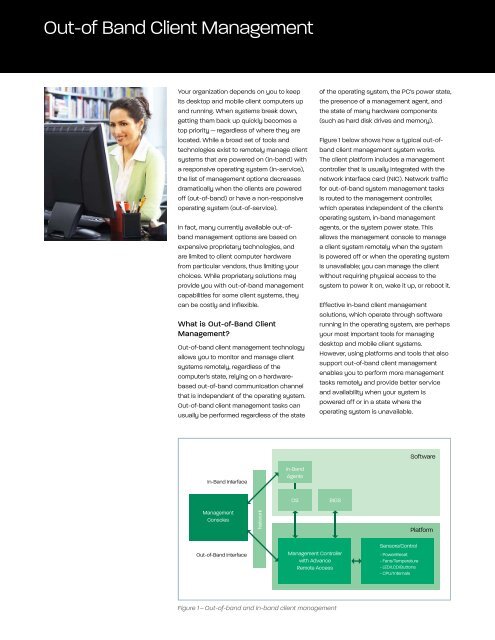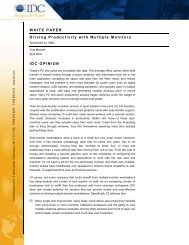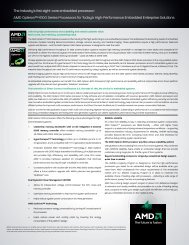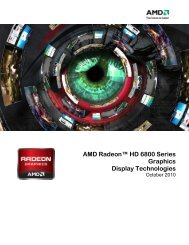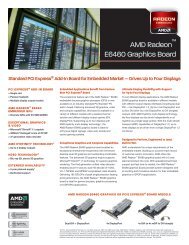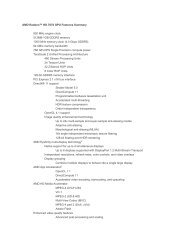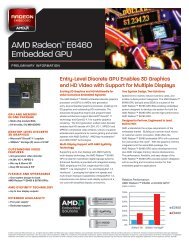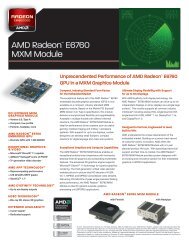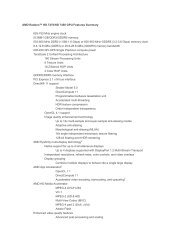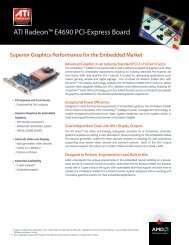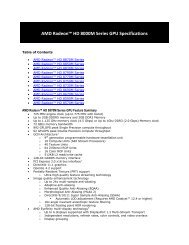Essential Manageability for Client Systems using DMTF DASH - AMD
Essential Manageability for Client Systems using DMTF DASH - AMD
Essential Manageability for Client Systems using DMTF DASH - AMD
Create successful ePaper yourself
Turn your PDF publications into a flip-book with our unique Google optimized e-Paper software.
Out-of Band <strong>Client</strong> Management<br />
Your organization depends on you to keep<br />
its desktop and mobile client computers up<br />
and running. When systems break down,<br />
getting them back up quickly becomes a<br />
top priority — regardless of where they are<br />
located. While a broad set of tools and<br />
technologies exist to remotely manage client<br />
systems that are powered on (in-band) with<br />
a responsive operating system (in-service),<br />
the list of management options decreases<br />
dramatically when the clients are powered<br />
off (out-of-band) or have a non-responsive<br />
operating system (out-of-service).<br />
In fact, many currently available out-of-<br />
band management options are based on<br />
expensive proprietary technologies, and<br />
are limited to client computer hardware<br />
from particular vendors, thus limiting your<br />
choices. While proprietary solutions may<br />
provide you with out-of-band management<br />
capabilities <strong>for</strong> some client systems, they<br />
can be costly and inflexible.<br />
What is Out-of-Band <strong>Client</strong><br />
Management?<br />
Out-of-band client management technology<br />
allows you to monitor and manage client<br />
systems remotely, regardless of the<br />
computer’s state, relying on a hardwarebased<br />
out-of-band communication channel<br />
that is independent of the operating system.<br />
Out-of-band client management tasks can<br />
usually be per<strong>for</strong>med regardless of the state<br />
Figure 1 – Out-of-band and in-band client management<br />
of the operating system, the PC’s power state,<br />
the presence of a management agent, and<br />
the state of many hardware components<br />
(such as hard disk drives and memory).<br />
Figure 1 below shows how a typical out-ofband<br />
client management system works.<br />
The client plat<strong>for</strong>m includes a management<br />
controller that is usually integrated with the<br />
network interface card (NIC). Network traffic<br />
<strong>for</strong> out-of-band system management tasks<br />
is routed to the management controller,<br />
which operates independent of the client’s<br />
operating system, in-band management<br />
agents, or the system power state. This<br />
allows the management console to manage<br />
a client system remotely when the system<br />
is powered off or when the operating system<br />
is unavailable; you can manage the client<br />
without requiring physical access to the<br />
system to power it on, wake it up, or reboot it.<br />
Effective in-band client management<br />
solutions, which operate through software<br />
running in the operating system, are perhaps<br />
your most important tools <strong>for</strong> managing<br />
desktop and mobile client systems.<br />
However, <strong>using</strong> plat<strong>for</strong>ms and tools that also<br />
support out-of-band client management<br />
enables you to per<strong>for</strong>m more management<br />
tasks remotely and provide better service<br />
and availability when your system is<br />
powered off or in a state where the<br />
operating system is unavailable.


